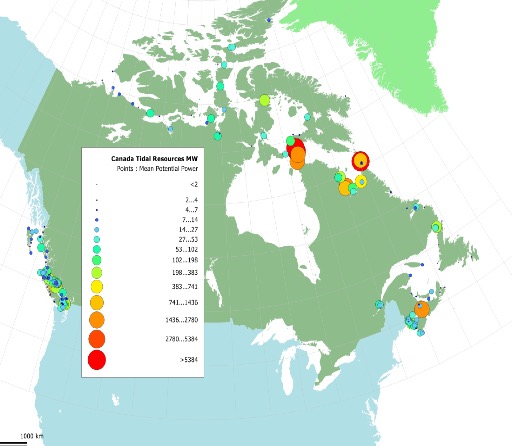Tidal Energy

Tidal energy is an abundant source of emission-free power.
Canada has an estimated tidal energy potential of 35,700 megawatts (MW). That’s enough clean power to displace over 113 million tonnes of CO2 – equal to removing over 24 million cars off the road.
The Minas Passage area of the Bay of Fundy is home to an estimated 7,000 megawatts of energy potential, roughly equal to the power needs of 2 million homes – or all of Atlantic Canada.
Tides are created by the gravitational pull of the sun, moon and the rotation of the earth. Their orbits are predictable; so is the availability of tidal energy.
Tidal resources are often found in narrow passages. As coastlines approach each other, or as the seafloor shallows, the water is ‘pinched.’ This pinch increases the speed of the water: like pressing a thumb on to a garden hose. Power goes up exponentially with speed; every time water speeds double, power goes up eight times.

Predictable
Tides deliver daily energy, on schedule.
As a renewable source of power, predictability is tidal energy’s game-changing strength. Intermittent renewables like wind and solar fluctuate: they require extra electrical infrastructure to ensure consumer demand for electricity is always met. Tidal is punctual: its availability can be predicted every day, every year, every century into the future. In the long run, tidal can offer system-wide cost-savings: its predictability cuts down on the need for extra power plants, extra transmission lines, and extra battery and smart grid storage.
Water vs Air
A tidal turbine must be more robust than a wind turbine, and for good reason: water is about 800 times denser than air.
The advantage of water density is that significant power can be produced with:
- slower rotation speeds (e.g. 6 RPM tidal versus 20 RPM wind), and
- smaller rotor diameters (e.g. 15-meter tidal versus 45-meter wind)
Tidal Stream Technology (also in-stream tidal, tidal current)
A tidal stream turbine uses the kinetic energy of moving water to produce electricity. Tidal stream technology is:
- Similar to a wind turbine under the water
- Placed in the natural flow of tidal currents
- Able to generate electricity on the outgoing (ebb) and incoming (flood) tides
Strengths of the technology include:
- Passive (allows water to flow freely through and around it, therefore smaller effects on water flow and sedimentation)
- Removable (if necessary)
- Scalable (they can be installed one device at a time, rather than built all-at-once)
- Low-impact (international research to date has shown no significant environmental effects)
Tidal Range Technology (also tidal barrage, tidal dam)
Tidal barrages work much like a conventional hydroelectric dam.
A tidal barrage contains water in a holding pool as the tide ebbs out. The height differential between the held water and the ebb tide creates potential energy; the held water can be converted to electrical energy when released through a turbine.
Canada is home to the only tidal barrage in North America in Annapolis Royal, Nova Scotia, which generated up to 20MW when it was in operation.
Two variations on tidal technology include:
Tidal Lagoon: A rock-walled impoundment built along a shallow ocean shoreline to create a ‘lagoon.’
Tidal Fence: An array of tidal stream devices connected to marine infrastructure running between two shorelines (e.g. a bridge). Energy is captured kinetically from the tidal flow, providing some freedom for marine life to pass between the turbines, and less restriction on tidal flow and area.
Tidal range technologies that are viewed as presenting more environmental risk than in-stream tidal technologies which can be deployed incrementally with any potential environmental impacts being mitigated and addressed more easily.
Canadian Leadership
Canada is emerging as a global leader in tidal energy, with:
- strong resource areas close to existing grid infrastructure
- international demonstration centres
- marine renewable energy legislation
- market incentives, including a feed-in tariff (FIT)
Some of the key organizations involved include:
- Acadia Tidal Energy Institute (ATEI): A non-profit organization conducting tidal energy research, training, education and outreach to promote responsible approaches to tidal energy development.
- Fundy Ocean Research Center for Energy (FORCE): Canada’s leading facility for tidal stream technology demonstration, including 64MW of subsea cable installed, a 30MW substation, tidal turbine test sites, and ongoing applied research and monitoring programs.
- Sustainable Oceans Applied Research (SOAR): A not-for-profit focused on advancing applied research as needed to help restore and maintain sustainable coastal communities and marine ecosystems, with focus areas in clean renewable energy and healthy food supplies.
Tidal Energy Projects
Canada has a number of tidal stream projects progressing in Nova Scotia as well as British Columbia. Check out our annual reports for the most recent updates on project activity.
In May 2022, Sustainable Marine, a tidal energy developer working in Nova Scotia, reached a significant milestone by successfully deploying its tidal technology in Grand Passage and connecting it to the grid. It has been operating reliably, providing clean electricity to the grid every day.
WATCH: Grid-connected floating tidal stream platform in Nova Scotia
Quick Stats
- 15 metres: Tidal range of Nova Scotia’s Bay of Fundy, the largest in the world
- 152,000 MW: Total potential capacity of the 27 best locations in the world for tidal stream farms
- 7 cents/kWh: Cost of power generated by the La Rance in France tidal barrage, cheaper than most competitors
- 20+: Countries currently investing in tidal power research and project development
